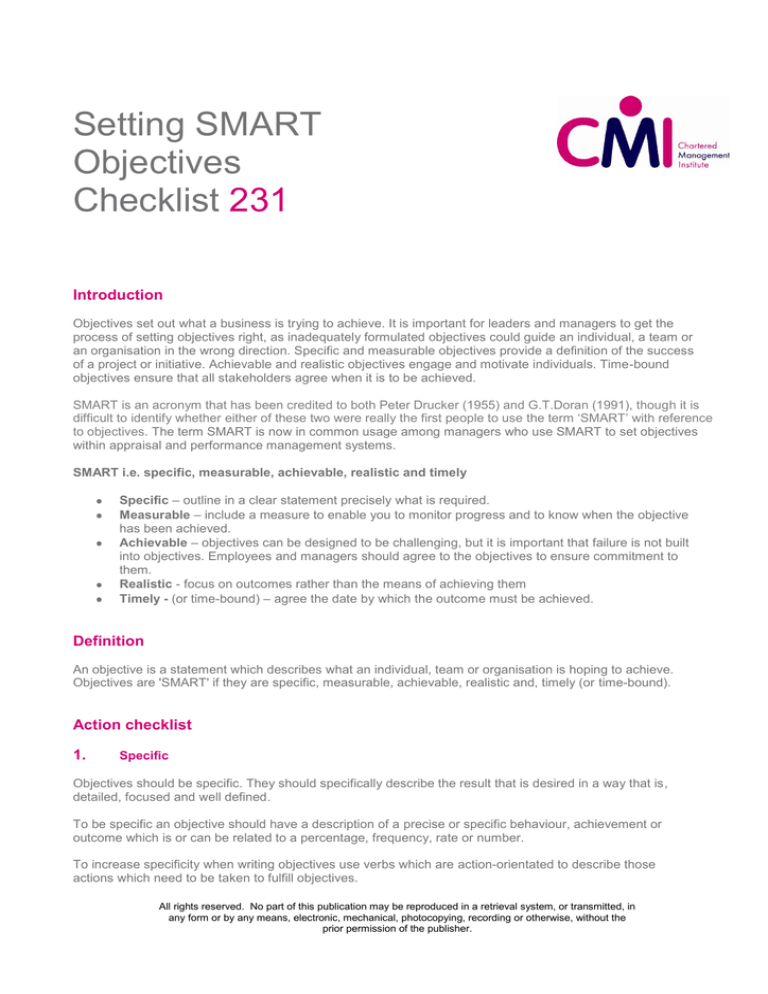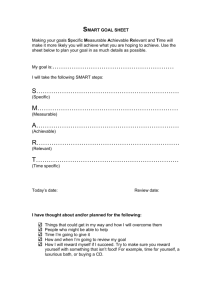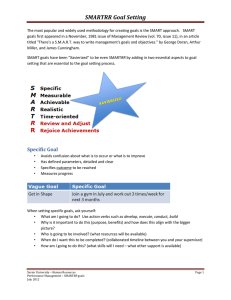
Setting SMART
Objectives
Checklist 231
Introduction
Objectives set out what a business is trying to achieve. It is important for leaders and managers to get the
process of setting objectives right, as inadequately formulated objectives could guide an individual, a team or
an organisation in the wrong direction. Specific and measurable objectives provide a definition of the success
of a project or initiative. Achievable and realistic objectives engage and motivate individuals. Time-bound
objectives ensure that all stakeholders agree when it is to be achieved.
SMART is an acronym that has been credited to both Peter Drucker (1955) and G.T.Doran (1991), though it is
difficult to identify whether either of these two were really the first people to use the term ‘SMART’ with reference
to objectives. The term SMART is now in common usage among managers who use SMART to set objectives
within appraisal and performance management systems.
SMART i.e. specific, measurable, achievable, realistic and timely
Specific – outline in a clear statement precisely what is required.
Measurable – include a measure to enable you to monitor progress and to know when the objective
has been achieved.
Achievable – objectives can be designed to be challenging, but it is important that failure is not built
into objectives. Employees and managers should agree to the objectives to ensure commitment to
them.
Realistic - focus on outcomes rather than the means of achieving them
Timely - (or time-bound) – agree the date by which the outcome must be achieved.
Definition
An objective is a statement which describes what an individual, team or organisation is hoping to achieve.
Objectives are 'SMART' if they are specific, measurable, achievable, realistic and, timely (or time-bound).
Action checklist
1.
Specific
Objectives should be specific. They should specifically describe the result that is desired in a way that is,
detailed, focused and well defined.
To be specific an objective should have a description of a precise or specific behaviour, achievement or
outcome which is or can be related to a percentage, frequency, rate or number.
To increase specificity when writing objectives use verbs which are action-orientated to describe those
actions which need to be taken to fulfill objectives.
All rights reserved. No part of this publication may be reproduced in a retrieval system, or transmitted, in
any form or by any means, electronic, mechanical, photocopying, recording or otherwise, without the
prior permission of the publisher.
Action verbs include:
analyse
apply
change
create
determine
differentiate
identify
perform
Avoid jargon, words and phrases which are (or can be construed as) misleading or ambiguous such as:
be aware of
have an awareness of
be prepared for a variety of
To help set specific objectives ask:
What are we going to do, with or for whom?
How will this be done and what strategies will be used?
Why is this important to do?
Is the objective (or objectives) understood?
Is the objective (or objectives) described with action verbs?
Who is going to be responsible for what and do we need anyone else to be involved?
Where this will happen?
When do we want this to be completed?
What needs to happen?
Is the outcome clear?
Will this objective lead to the desired results?
2.
Measurable
Measurement is hugely important and will enable you to know that the objective has been achieved because
evidence is available derived from a system, method or procedure which has tracked and recorded the
behaviour or action upon which the objective is focused.
Consider:
How will I know that the change has occurred?
Can these measurements be obtained? (It is worth noting that if it can’t be measured now, the chances
are that it won’t be possible to measure in the future either).
3.
Achievable
Objectives need to be achievable. They can be stretching but not unachievable. Ask whether, with a
reasonable amount of effort and application, the objective is achievable.
An objective is achievable if:
you know that it is measurable
others have already done it
it is in principle possible (it is clearly not unachievable)
the necessary resources are available, or there is a realistic chance of getting them
the limitations have been assessed.
Setting objectives that are unachievable will lessen motivation and lead to people applying little or no energy
or enthusiasm to what they see as a futile task. Setting objectives at too low a level can be just as dispiriting.
All rights reserved. No part of this publication may be reproduced in a retrieval system, or transmitted, in
any form or by any means, electronic, mechanical, photocopying, recording or otherwise, without the
prior permission of the publisher.
Recognise that by declaring an objective to be achievable you may be making a commitment to provide a
level of resources (staff, money) without which the objective would not be achievable, implying that in
changed circumstances the objective would no longer be SMART for the individual, team or organisation.
4.
Realistic
Whilst objectives should be realistic this does not mean that they need to be easy. They can stretch
individuals, teams or organisations responsible for the achievement of the objectives. Objectives can be set
which are demanding but not so much that the chance of success is small. Realistic objectives take into
account the available resources such as, skills, funding, and equipment.
You need to know:
Is it possible to achieve this objective?
Who is going to do it?
Do they have the necessary skills to do the task well?
Where is the funding coming from?
Are the resources to achieve this objective available?
Who will bear responsibility for what?
5.
Timely / (or time-bound)
A deadline, date or time when the objective will be accomplished or completed is necessary and must be
included so as to make the objective measurable.
A deadline helps to create the necessary urgency, prompts action and focuses the minds of those who are
accountable for the commitments that they have made through the objectives. Not setting a deadline reduces
the motivation and the urgency of those required to perform the tasks.
Ask yourself if the objective can be accomplished within the deadlines which have been established, bearing
in mind other possible competing demands which may cause delay.
The objective setting process can seem intimidating but it doesn't necessarily need to be as it can be as
simple as sitting down with the departmental objectives and considering how these objectives can be met.
From the answer to the question comes the foundation for setting the objectives. Everyone within the
organisation should have a clear understanding of the objectives as well as an awareness of their own roles
and responsibilities in achieving them.
Managers should avoid:
failing to set objectives which are specific
having no system, method or procedure in place to track and record the behaviour or action upon
which the objective is focused
setting objectives which are unachievable
setting objectives which are unrealistic
not having time-frames for the achievement of the objective or objectives
setting deadlines which are neither achievable or realistic.
failing to remember that situations change and therefore individuals may need to return to
renegotiate objectives if situations make them less certain or impossible
National Occupational Standards for Management and Leadership
This checklist has relevance for the following standards:
B Providing direction, units 5, 6, 7, 9
All rights reserved. No part of this publication may be reproduced in a retrieval system, or transmitted, in
any form or by any means, electronic, mechanical, photocopying, recording or otherwise, without the
prior permission of the publisher.
Additional resources
Books
Target setting and goal achievement, Richard Hale and Peter Whitlam
London: Kogan Page, 1995
Goals and goal setting: planning to succeed, Larrie A Rouillard
London: Kogan Page, 1994
Goal analysis, 2nd ed, Robert F Mager
London: Kogan Page, 1991
Management excellence: productivity through MBO, Heinz Weihrich
New York NY: McGraw Hill, 1985
The practice of management, Peter Drucker
London: Heinemann, 1955
This is a selection of books available for loan to members from CMI’s library. More information at:
www.managers.org.uk/library
Related checklist
Setting objectives (052)
Related model
SMART objectives
Internet resources
This SMART task template assists with the writing of objectives which conform to the SMART criteria
www.businessballs.com/delegationsmarttaskform.pdf
This is one of many checklists available to all CMI members. For more information please contact
t: 01536 204222
e: enquiries@managers.org.uk
w www.managers.org.uk
Chartered Management Institute
Management House, Cottingham Road, Corby NN17 1TT.
This publication is for general guidance only. The publisher and expert contributors disclaim all liability for
any errors or omissions. You should make appropriate inquiries and seek appropriate advice before making
any business, legal or other decisions. Where legal or regulatory frameworks or references are mentioned
these relate to the UK only.
Revised March 2011
All rights reserved. No part of this publication may be reproduced in a retrieval system, or transmitted, in
any form or by any means, electronic, mechanical, photocopying, recording or otherwise, without the
prior permission of the publisher.


